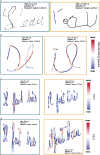Automated human-level diagnosis of dysgraphia using a consumer tablet
- PMID: 31304322
- PMCID: PMC6550155
- DOI: 10.1038/s41746-018-0049-x
Automated human-level diagnosis of dysgraphia using a consumer tablet
Abstract
The academic and behavioral progress of children is associated with the timely development of reading and writing skills. Dysgraphia, characterized as a handwriting learning disability, is usually associated with dyslexia, developmental coordination disorder (dyspraxia), or attention deficit disorder, which are all neuro-developmental disorders. Dysgraphia can seriously impair children in their everyday life and require therapeutic care. Early detection of handwriting difficulties is, therefore, of great importance in pediatrics. Since the beginning of the 20th century, numerous handwriting scales have been developed to assess the quality of handwriting. However, these tests usually involve an expert investigating visually sentences written by a subject on paper, and, therefore, they are subjective, expensive, and scale poorly. Moreover, they ignore potentially important characteristics of motor control such as writing dynamics, pen pressure, or pen tilt. However, with the increasing availability of digital tablets, features to measure these ignored characteristics are now potentially available at scale and very low cost. In this work, we developed a diagnostic tool requiring only a commodity tablet. To this end, we modeled data of 298 children, including 56 with dysgraphia. Children performed the BHK test on a digital tablet covered with a sheet of paper. We extracted 53 handwriting features describing various aspects of handwriting, and used the Random Forest classifier to diagnose dysgraphia. Our method achieved 96.6% sensibility and 99.2% specificity. Given the intra-rater and inter-rater levels of agreement in the BHK test, our technique has comparable accuracy for experts and can be deployed directly as a diagnostics tool.
Keywords: Diagnosis; Patient education.
Conflict of interest statement
Competing interestsThe authors declare no competing interests.
Figures




Similar articles
-
Tools and Methods for Diagnosing Developmental Dysgraphia in the Digital Age: A State of the Art.Children (Basel). 2023 Dec 14;10(12):1925. doi: 10.3390/children10121925. Children (Basel). 2023. PMID: 38136127 Free PMC article. Review.
-
Dysgraphia Differs Between Children With Developmental Coordination Disorder and/or Reading Disorder.J Learn Disabil. 2024 Nov-Dec;57(6):397-410. doi: 10.1177/00222194231223528. Epub 2024 Jan 29. J Learn Disabil. 2024. PMID: 38284390
-
Acquisition of handwriting in children with and without dysgraphia: A computational approach.PLoS One. 2020 Sep 11;15(9):e0237575. doi: 10.1371/journal.pone.0237575. eCollection 2020. PLoS One. 2020. PMID: 32915793 Free PMC article.
-
Extending the Spectrum of Dysgraphia: A Data Driven Strategy to Estimate Handwriting Quality.Sci Rep. 2020 Feb 21;10(1):3140. doi: 10.1038/s41598-020-60011-8. Sci Rep. 2020. PMID: 32081940 Free PMC article.
-
From micrographia to Parkinson's disease dysgraphia.Mov Disord. 2014 Oct;29(12):1467-75. doi: 10.1002/mds.25990. Epub 2014 Aug 22. Mov Disord. 2014. PMID: 25156696 Review.
Cited by
-
Analysis of Graphomotor Tests with Machine Learning Algorithms for an Early and Universal Pre-Diagnosis of Dysgraphia.Sensors (Basel). 2021 Oct 23;21(21):7026. doi: 10.3390/s21217026. Sensors (Basel). 2021. PMID: 34770333 Free PMC article.
-
A Comparison of Social Robot to Tablet and Teacher in a New Script Learning Context.Front Robot AI. 2020 Oct 7;7:99. doi: 10.3389/frobt.2020.00099. eCollection 2020. Front Robot AI. 2020. PMID: 33501266 Free PMC article.
-
Automated Early Detection of Alzheimer's Disease by Capturing Impairments in Multiple Cognitive Domains with Multiple Drawing Tasks.J Alzheimers Dis. 2022;88(3):1075-1089. doi: 10.3233/JAD-215714. J Alzheimers Dis. 2022. PMID: 35723100 Free PMC article.
-
Assessing handwriting skills in a web browser: Development and validation of an automated online test in Japanese Kanji.Behav Res Methods. 2024 Dec 30;57(1):32. doi: 10.3758/s13428-024-02562-6. Behav Res Methods. 2024. PMID: 39738808 Free PMC article.
-
Tools and Methods for Diagnosing Developmental Dysgraphia in the Digital Age: A State of the Art.Children (Basel). 2023 Dec 14;10(12):1925. doi: 10.3390/children10121925. Children (Basel). 2023. PMID: 38136127 Free PMC article. Review.
References
-
- Graham S. The role of production factors in learning disabled students’ compositions. J. Educ. Psychol. 1990;82:781. doi: 10.1037/0022-0663.82.4.781. - DOI
-
- Berninger VW, et al. Treatment of handwriting problems in beginning writers: transfer from handwriting to composition. J. Educ. Psychol. 1997;89:652. doi: 10.1037/0022-0663.89.4.652. - DOI
-
- Bourdin B, Fayol M. Is written language production more difficult than oral language production? A working memory approach. Int. J. Psychol. 1994;29:591–620. doi: 10.1080/00207599408248175. - DOI
-
- Bourdin B, Fayol M. Is graphic activity cognitively costly? A developmental approach. Read. Writ. 2000;13:183–196. doi: 10.1023/A:1026458102685. - DOI
LinkOut - more resources
Full Text Sources
Other Literature Sources

